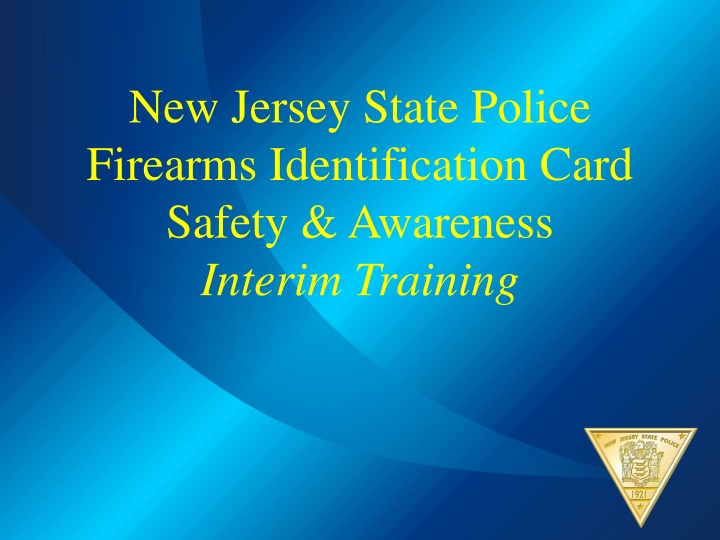New Jersey State Police Firearms Identification Card Safety & Awareness Interim Training
The New Jersey State Police, in partnership with the Office of the Attorney General, is developing a comprehensive training program for individuals applying for or renewing a permit to carry a handgun in compliance with relevant statutes. The program includes both online resources and in-person classroom instruction to ensure applicants understand safe firearm handling practices. Until the new training is fully implemented, certified firearms instructors are responsible for teaching applicants about firearm safety. The provided guidelines aim to enhance general safety awareness regarding firearm care, handling, and storage, in alignment with international rules of firearms safety.
Download Presentation

Please find below an Image/Link to download the presentation.
The content on the website is provided AS IS for your information and personal use only. It may not be sold, licensed, or shared on other websites without obtaining consent from the author.If you encounter any issues during the download, it is possible that the publisher has removed the file from their server.
You are allowed to download the files provided on this website for personal or commercial use, subject to the condition that they are used lawfully. All files are the property of their respective owners.
The content on the website is provided AS IS for your information and personal use only. It may not be sold, licensed, or shared on other websites without obtaining consent from the author.
E N D
Presentation Transcript
New Jersey State Police Firearms Identification Card Safety & Awareness Interim Training
Important Notes The NJSP, in conjunction with the Office of the Attorney General, is working to establish a new comprehensive training program for applicants who are applying for, or renewing, a permit to carry a handgun, pursuant to N.J.S.A. 58-4(g)(1) and (g)(2). See also N.J.S.A. 2C:58-4(d)(3). In addition to online materials and firing range requirements, the newly developed training will include an in-person classroom component, where applicants will learn first-hand from authorized certified instructors the principles of lawful and safe handling and safe storage of firearms. The live component will be standardized across the state to ensure all applicants are provided the same meaningful opportunity to receive a permit to carry. Until such time that the new training is implemented, and in order to comply with the law, this document on safe handling and use, as well as the training materials on use of deadly force shall be taught by a certified firearms instructor to all applicants. Certified firearms instructors remain responsible for ensuring that applicants for permits to carry handguns are properly trained and proficient before attesting to the applicant s competence on the prescribed certification form. The material and content being presented to the viewer is intended to provide general safety awareness guidelines regarding the safe care and handling of firearms. It is not intended to supersede or be in lieu of any manufacturer guidelines, recommendations or instruction provided by a competent certified Firearms Instructor. Please refer to the NJ Criminal Code 2C to ensure compliance with all matters related to the care, handling, and transportation of firearms.
Safety International Rules of Firearms Safety These rules are in place to lessen the possibility of accidental injury.
International Rules of Firearms Safety 1. Treat every firearm as if it were loaded until positively ascertained otherwise by you. Ensure to visually and physically inspect the chamber of the weapon to establish that it is clear and safe from any live rounds or debris.
International Rules of Firearms Safety (continued) 2. Never point a firearm at anything or anybody that you do not intend to shoot, or in a direction where an unintentional discharge may do harm.
International Rules of Firearms Safety (continued) 3. Never place your finger on the trigger until ready and justified to fire. Trigger Finger Discipline: Build tactile sensation. Keep your trigger finger oriented high on the frame of the weapon at all times, unless you are ready and justified to fire.
International Rules of Firearms Safety 4. Be sure of your threat, surroundings and beyond. You are responsible for all of your rounds including those that miss your intended target.
Everyone is part of the safety paradigm. Safety Acknowledgement
Additional Rules of Firearms Safety Muzzle Discipline (Laser Rule): Be cognizant and aware of where your muzzle is always oriented. Treat the end of the barrel as if it had a laser through it and you do not want the laser to make contact with an unintended target Never hand a loaded weapon to someone in a non- combat situation
The world is 360. There is no down range.
Safety The best safety device is between your ears think safety first at all times!
Home Safety Guidelines All firearms should be unloaded and made safe prior to storage in a household Secure the firearm in a safe place (locked and unloaded), follow manufacturer guidelines on how to properly utilize the trigger lock device to render the weapon inoperable Ensure that the ammunition and magazines are locked and secured in a separate location from the firearm Educate your family as to its dangers Do Not show children how to load the weapon Do Not store firearm in an easy access area (under pillow, under mattress, in nightstand. Should be kept in a locked container, drawer, or other location as far out of a child s reach as possible)
Home Safety Guidelines (continued) General guidelines are to render the weapon inoperable and inaccessible when storing them Children: (Have a plan on how to educate them and properly store the firearm and follow it) N.J.S.A. 2C:58-15 A person who knows or reasonably should know that a minor is likely to gain access to a loaded firearm at a premises under the person s control commits a disorderly persons offense if a minor gains access to the firearm
Semiautomatic Handgun and Revolver Nomenclature
Purpose To provide general knowledge of different types weapons Please refer to the respective firearm manufacturer for specific nomenclature and operating procedures. In addition, refer to a certified firearms instructor for instruction on how to operate a firearm
Semiautomatic Handheld firearm in which depressing the trigger, when the magazine and chamber are loaded, will: Fire the chambered round Extract and eject the spent shell casing Cock the weapon Load and chamber a round from the magazine
Semiautomatic (continued) Trigger must be pressed for each round to be fired All semiautomatic handguns are similar by design, however most disassemble differently
Semiautomatic Handgun Nomenclature Receiver Magazine Magazine Release Barrel Slide Slide Stop Lever Firing Pin Safety(s) Hammer or Striker Trigger Guard Trigger Sights Grip Ejection Port Recoil Spring Bore, Lands, Grooves Extractor Ejector
Making a Semiautomatic Safe 1. Safety (if applicable) 2. Point the weapon in safe direction 3. Remove the source of ammunition (magazine) 4. Lock the slide to the rear 5. Visually and Physically check the chamber
Safety Rendering a semiautomatic handgun safe DO NOT TRAP ROUND Safely allow for the round to eject onto the floor, do not attempt to catch
Revolver Handheld firearm in which the cartridges are inserted in individual chambers in a cylinder, which is mounted behind the barrel. The cylinder revolves to bring the chamber and cartridge in line with the firing pin.
Revolver Cylinders generally swing out to the left May have an exposed or hidden hammer Double action Colt cylinders rotate clockwise Ruger and Smith & Wesson cylinders rotate counterclockwise
Revolver Nomenclature Muzzle Front Sight Barrel Frame Rear Sight Top Strap Crane Ejection Rod Cylinder Trigger Guard Trigger Grip Panel Back Strap Cylinder Release Chambers Extractor Rachet
Making a Cocked Revolver Safe Non-shooting hand thumb is placed between hammer and frame (weapon pointed in safe direction) Press trigger and release hammer onto thumb Remove finger from trigger Remove thumb from between hammer and frame Gently lower the hammer
Notable NJ Criminal Statutes related to Firearms 2C:24-4 (Endangering the Welfare of a Child) 2C: 39-6g (Transporting a Firearm within NJ) 2C:58-15 (Loaded Firearm easily accessible to minor)
Notable NJ Criminal Statutes related to Firearms 2C:58-4.6 Prohibited Places (3rd degree crime to enter a prohibited place with a firearm). See Koons/Siegel v. AG/NJSP case for current status of the prohibited places law. As of July 1, 2023, the following are included in the prohibited places under N.J.S.A. 2C:58-4.6: government buildings courthouses/buildings used for court administrative proceedings state, county, municipal jails/prisons, juvenile detention centers state-contracted half-way houses poling locations during election w/in 100 ft of public gatherings/demonstrations schools, colleges, universities, other education institutions, and school buses child care/daycares nursery schools, pre-schools, zoos, summer camps parks, beaches, recreation facilities, and playgrounds owned by the state, county, or local gov t youth sports events libraries and museums homeless shelters/children s shelters community residences for people w/developmental disabilities, head injuries, or terminal illness, and other DHS licensed residential settings places that serve alcohol cannabis retailers entertainment facilities (theaters, museums, racetracks, concert venues) casinos energy plants airport or public transportation hubs healthcare facilities and addiction/mental health treatment centers DHS, DCF, or DOH regulated addiction or mental health facilities (non-healthcare)
Notable NJ Criminal Statutes related to Firearms N.J.S.A. 2C:58-4.5 Restrictions on Lawful Carrying It is a 4th degree crime to openly carry, regardless of liability insurance. See Koons/Siegel v. AG/NJSP case for applicability of the liability insurance provisions. As of July 1, 2023, the liability provision is enjoined. N.J.S.A. 2C:58-4.4 Safe Carry Requirements: (a) Lawful holders of a permit to carry a handgun cannot: 1.use or consume alcohol, cannabis, or CDS while carrying a handgun; 2.be under the influence of alcohol, cannabis, or CDS while carrying a handgun; 3.carry outside of the holster or carry in public in a holster that does not meet the carry permi requirements (2C:58-4); (4) carry more than 2 firearms at one time; or 4.engage in unjustified display of a handgun. Violation of the above is a 4th degree and constitute sufficient grounds for permit revocation. (b) If an individual is stopped or detained by LE while lawfully carrying a handgun in public or in a vehicle, the individual must: 1.immediately disclose they are carrying a handgun or that it is stored in the vehicle (violation is a 4th degree); and 2.display the lawful carry permit (violation is a DP for first offense and $100 fine (4th degree for subsequent offenses). 3.An individual who has a permit to carry and is carrying at the time they are detained as part of a criminal investigation, the individual must provide their handgun to the officer upon the officer s request (violation is a 4th degree).**























